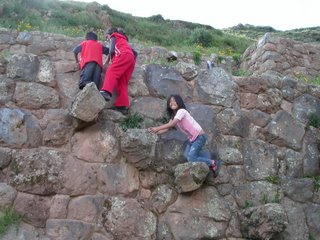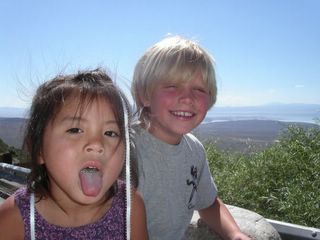Tipón




On Sunday we went with a local family to the nearby pueblo of Saylla for the afternoon. Many people work six day weeks so Sunday is the big day of relaxation. Accompanying the three Braunwarth were four other children: sibings Carmello (12), Carolina (8), and Carlo (6) and their cousin Paola (8). Shepherding the kids was the mom of the first three and her 20 something neice, Janette, who was a cousin to the others but essentially a generation older. Carmello was a very nice kid and he and Zak accompanied each other on the adventures of the day. Carolina spent a lot of time taking care of Maya and her and Paola amused each other as well. Carlo, or Carlito, was a wild one: nonstop, no boundaries, full-tilt boy. The town of Saylla is not too far outside of Cusco and consists mainly of a number of restaurants all serving Chicharrones to visitors from Cusco. It was nice to get out of Cusco and see some green trees and hills and mountains. We traveled by combi, which is essentially a large van packed with many seats, and many people packed into the seats, and still others packed into the aisles, while any remaining open space was packed with packages, boxes, and bags. All of this packing did little to diminish the wet-dog sour-ish aroma of unwashed bodies wafted up around us but the combi got all nine of us there at what I thought to be a reasonable pace at a price of less than 5 sols (about $1.50). The aunt thoughtfully brought along some ears of Choclo (corn) and cheese for us to eat while we traveled. The corn here has huge kernels which are picked off one at a time and popped into one’s mouth, like the olives at the bottom of an empty martini glass. The corn was not as sweet as the sugary sweet corn of the Midwest summers of my youth and was served sans butter or seasoning but was, nonetheless, satisfying. Lunch was fun, we ate chicharrones, as that was practically the only thing offered in the whole town, at an outdoor café while the kids ran amuck in the garden. I bought a couple of those spring loaded plastic suction cup guns from a vendor so the kids could amuse each other by pretending to shoot each other dead. Carlo, not unsurprisingly, took the game like a wino takes to Gallo and was very reluctant to allow others the opportunity to feign homicide. I bought lunch for the group which was only 48 sols (about $16) for all nine of us. After lunch we hired a taxi to take us to the ruins at Tipón. The taxi, a Toyota corolla wagon, actually accommodated all nine of us in such grand comfort relative to the combi that we hired the drive to take us all they way back to Cusco for a grand total of 25 sols (about $8) including waiting time while we explored the ruins. The route to the ruins passed through the pueblo of Tipón which featured a few small restaurants along the main road, all serving roast cuy. Apparently specialty foods are grouped according to location; can you imagine the aroma wafting over the baked bean town and the smell of the bathrooms in the asparagus town? Behind the commercial strip of Tipón, such as it was, we passed through the residential portion of te farming community which consisted of a few dozen mud brick houses, a small church on a small dirt square and a number of little kids herding cows, horses, and sheep with handheld switches. One could recognize the store selling chicha (corn beer) in town by the blue plastic bag tied to a pole outside the front door and, not un-coincidentally, I did spy one young man passed out drunk on a side street. The scenery on the way back was enlivened by a couple of particularly picturesque girls who had bundles of sticks tied to their backs with brightly colored scarves (a la the cover of Led Zepplin IV). They were apparently bringing the sticks home for use in cooking the family’s dinner. The road to the ruins at Tipón crawled over a small mountain range littered with grazing cows and sheep happily munching roadside grass however we encountered no problems except for when we met another taxi just outside of the ruins. The one-lane road hugged the mountain on one side and dropped off a thousand feet or so on the other to the valley below. The other driver clearly did not want to give way but, after a minor standoff and a few coarse words, the vehicles were able to squeeze past each other.
The ruins themselves were incredible. When Mary and I visited ruins in Greece and Turkey, the ruins were just that, ruined. We would look at a pile of rubble and then look at the artists’ depictions of what the rubble used to look like and we duly appreciated, in an entirely cerebral manner, the importance of these once grand structures. But the ruins at Tipón were entirely different. First, although they were constructed over 500 years ago, they weren’t ruined. They were amazingly well preserved and could easily be put to their original use tomorrow; one was immediately struck by the visceral vitality of the place. The site consisted of a series of level fields built into the head of a small valley. There were roughly a dozen or more larger fields, each about the size of a baseball diamond, and many more smaller ones. The fields were stacked about ten feet above each other and were all terraced with perfectly-fitted, massive blocks of stone. Access to fields was provided by large flat-top stones which stuck out of the walls about a foot or two, each a couple of feet above the other along a diagonal, providing a sort of open air stair from one level to the other. There were dozens of these stairs and they alone were worth the price of admission but the most striking feature of the site was the water. Stone-lined irrigation channels flowed along the side of each field and waterfalls tumbled down, not unlike Jack and Jill after there illicit tryst up by the well, from one level to the next. The tops and basins of the waterfalls were constructed in such a way that essentially no water was lost as it cascaded down. The scale, grandeur, and sheer functionality of the site were very impressive and, apparently, this is one of the lesser sites in the area. My guidebook only gives a couple of sentences about how Tipón is an excellent example of the Inca’s mastery over their environment. The Incan motto for Cusco, which has been retained by the contemporary city, is “the navel of the world.” To me, this connotes a nurturing, maternal centrality which really seems to fit Cusco much in the same way “America’s finest city” fits the more external, plastic attractiveness of San Diego (“Don’t hate us because we’re beautiful!”). Having always been fond of navels (some people’s more than other's) I am looking forward to discovering whatever else this area has to offer.


0 Comments:
Post a Comment
<< Home